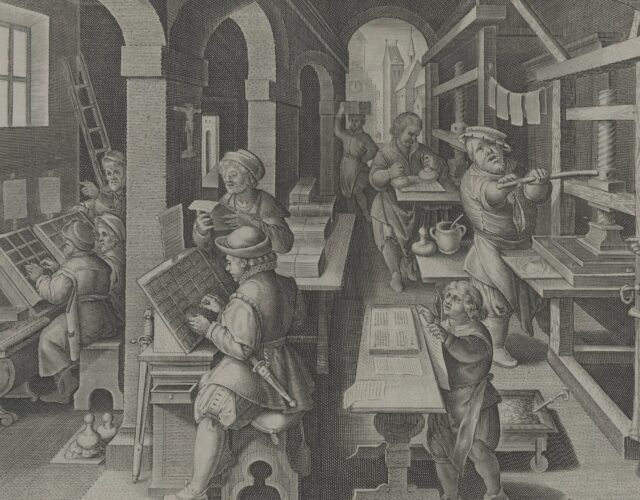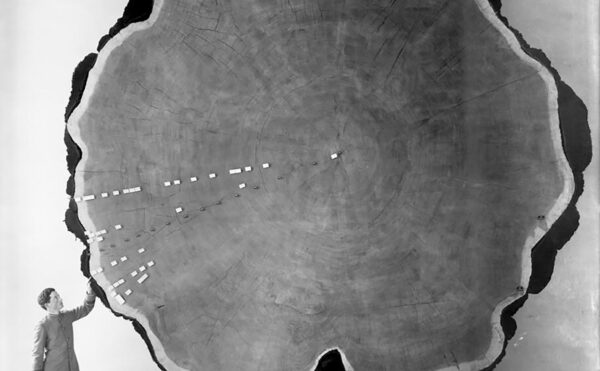Books cheerfully proclaim their origin. They tell us right on the title page where they were printed, by whom, and when. And for the most part historians and librarians take them at face value. We have to: radical skepticism toward the information they provide would leave us adrift. But books sometimes lie to us.
A few years ago I became interested in 17th-century chemical textbooks. These books mark an interesting change in chemical publication. Written mostly in vernacular languages rather than Latin and largely eschewing the flamboyant metaphors of transmutational alchemy, they represent the professionalization of chemistry. They are practical in nature, catering to pharmacy students, a small audience based at newly established university programs or attending private courses offered by pharmacists across Europe.
For decades historians have pointed to Nicolas Lemery’s Cours de chymie as the epitome of this genre. First published in 1675, it went through a dozen editions and far more printings and translations into all major European languages. Along the way it expanded, growing from a little book you could drop in your pocket to a hefty tome. Tracking this expansion seemed like the perfect way to study the rapid growth of chemistry in that pivotal time. But almost immediately my project went off the rails.
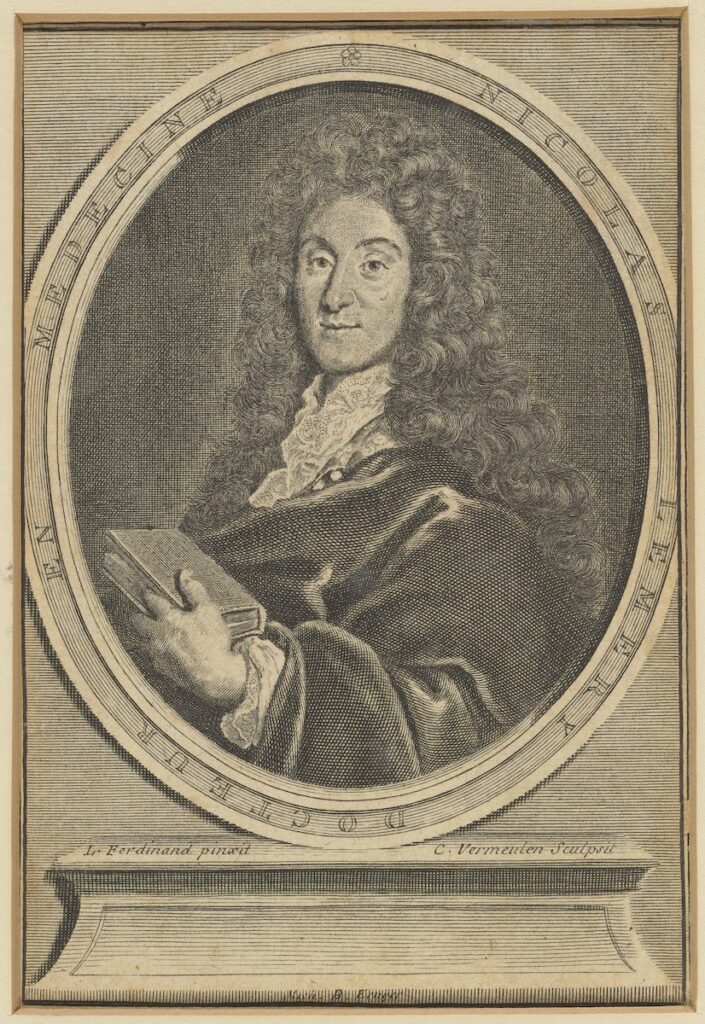
After Lemery’s first edition in 1675, a second followed in 1677. And like clockwork a third edition appeared in 1679. But that same year a second second edition appeared that had the same number of pages as the 1677 second edition. Could demand have been so intense that Lemery reprinted the second edition the same year in which he released the updated third edition? Then the same thing happened again: a second third edition appeared in 1681 followed by the fourth edition the same year. Then two fifth editions appeared in 1683, one of which wasn’t any different than the fourth edition. The sixth edition in 1687 was followed by an identical seventh in 1688, but then an updated edition also numbered seventh appeared in 1690. What on earth was going on?
It turns out I had stumbled onto a pattern of rampant intellectual property theft. The second second edition wasn’t published in Paris by Nicolas Lemery as it claimed. The year may have been updated—fresh stock sells—but the book was counterfeit.
These extra editions were pirated, and in retrospect they are not too hard to spot. Although their title pages are usually word-for-word copies of the originals—with the exception of the updated publication date—there are tells. The crooks’ brazenness in ripping off the second edition was the most comically egregious and provided the hint as to the source of these unauthorized editions. For although the book purported to have been published by Lemery in Paris, there in the decorative headpiece on page one are the arms of the city of Lyon, where a pirate publishing industry was flourishing.
The impetus for this particular crime spree was a series of measures put in place by the French government to exert control over printers. Louis XIV and his advisers—specifically, Jean-Baptiste Colbert—saw danger in free expression. There were an uncomfortable number of small print shops with only one or two presses that were difficult to keep tabs on and, when idle, might resort to unregulated printing of heterodox or politically incendiary tracts. The government’s strategy was to consolidate printing in a smaller number of larger print shops, the reasoning being that the larger ventures would be easier to regulate and their owners would have more to lose and thus less incentive for unauthorized printing. At the same time, the government made its oversight work easier by granting privilèges, or copyrights, exclusively to Parisian printers, effectively creating a monopoly on printing in the city. This policy left provincial printers out of (legitimate) business. In Lyon printers responded by flouting the regulations and engaging in outright piracy.
Given this particular context, where a large proportion of the output of a printing center intentionally misrepresents its origins, how are we to tell which books are lying about themselves and which are not? One dependable way is the historical record.
Consider an example from Lyon but from a century before Lemery, when, ironically, Lyonnais printers loudly complained they were being pirated. In 1588 the ruling council of Lyon summoned a group of printer-booksellers to appear before the council in the presence of journeyman printers to publicly lambaste the former group for ruining Lyonnais printing:
This fraudulent activity, the council maintained, destroyed the reputation of Lyon and denied the journeymen work, or worse still, forced them to relocate to Geneva, where they would become heretics.
The offending printer-booksellers were Protestants, formerly of Lyon, who had transferred their printing operations to Geneva in the face of rising religious intolerance. In 1572 the city had experienced the so-called Lyon Vesper, a slaughter of Protestants that followed the St. Bartholomew’s Day massacre in Paris. In its wake the printers had relocated their operations to tolerant, Protestant Geneva. But to keep their traditional markets, they continued to use Lyon in their imprints.
The Othmer Library holds a book from one of these publishers, Antoine de Harsy, an edition of Paracelsus’s Grande chirurgie from 1603. And sure enough, on the title page underneath de Harsy’s moth-and-crab printer’s mark, it says, “A Lyon, pour Antoine de Harsy. MDCIII. Avec privilège du Roy.” I suspect that of those four assertions, only two are correct—the date and de Harsy’s identity. I strongly doubt that it was printed in Lyon or that it received a royal privilège.
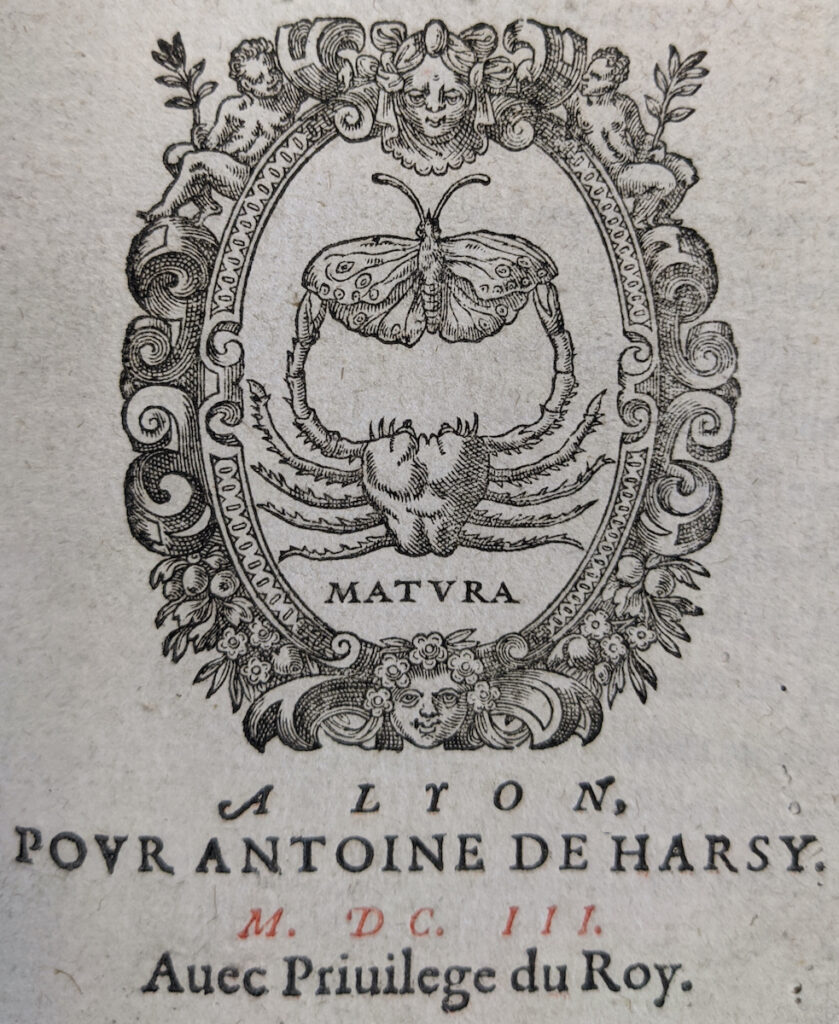
But how could I be sure whether it was printed in Lyon or in Geneva, as the town council accused? To attempt to answer that question we need to delve into the field of forensic bibliography. Books offer many clues hidden in plain sight. The majority of readers focus their attention on the text on the page, but there are additional features that might betray a book’s origin.
Let us begin with a book’s signatures. From the dawn of printing until the early 19th century, books were printed on single sheets of handmade paper that were limited by the size of the papermaker’s mould, about the dimensions of a modern cafeteria tray. Depending on the format of the book, multiple pages of text were printed on each sheet. Then the sheets were folded to make a signature, and the signatures were bound together to make the book. The largest books had two pages printed on each side, and the sheet was folded in half. Smaller books had four or eight or more pages printed on each side and were folded two or three times to make signatures that were bound together to make a book. To keep track of the book’s components, printers used a scheme of letters, numbers, and symbols. (Page numbers were a later development for the convenience of readers.)
By the 16th century the text of a book was typically printed first, beginning at page one; the title page, dedication, foreword, table of contents, and so on were printed last. (That is why front matter to this day is not included in the normal run of Arabic page numbers and is separately numbered with Roman numerals.) The notation used to number these components can tell us a lot about who made them. English printers liked to start printing the text on signature B, later printing the front matter, starting on A. Parisian printers marked, or signed, the signatures of their front matter with vowels and tildes (ã, ẽ, ĩ, õ, ũ). The Dutch preferred asterisks (*, **, ***).
There are other telltale signs of a book’s origin. Subsections of the signatures called bifolia could be numbered with Arabic numerals (A, A2, A3) or Roman numerals (A, Aij, Aiij). If using Roman, some printers chose the terminal consonant form (Aij), while others preferred the vowel form most people are familiar with today (Aii). It turns out the latter practice is a peculiarity limited to Geneva in the second half of the 16th century, long after it had been abandoned elsewhere in Europe. Myriad other clues exist in the signing of signatures—in the placement of catchwords and in the letterforms chosen (U vs. V, s vs. ſ)—that taken together constitute a kind of fingerprint that may betray a book’s actual origin.
So what can all this information tell us about the books under scrutiny? Let’s begin with Lemery’s Cours de chymie. It turns out Parisian printing was remarkably characteristic and consistent during the late 17th and early 18th centuries. Preliminary signatures were signed with vowels with tildes over them; the first half of a signature was signed; the Roman numerals ij, iij, iiij, v, and vj were used; and there were catchwords only on the final page of a signature. The first two editions of the Cours de chymie were self-published by Lemery and sold out of his premises on the rue Galande. They were printed by his neighbor Jacques Langlois II, scion of a large and well-established printing family. And as one might expect, they were expertly printed in strict adherence to Parisian practice.
Many of the pirated editions, in contrast, departed from these conventions. In the sloppiest cases the Lyonnais fakers blended numbering schemes and even repeated and mixed up the numerical order. But not all of the frauds were so easy to detect. The seventh pirate edition of 1688 is a character-by-character reprint of the sixth authorized edition of 1687. If the engravings of apparatus had not been replaced with cruder woodcut copies, it would be nearly impossible to distinguish the two.
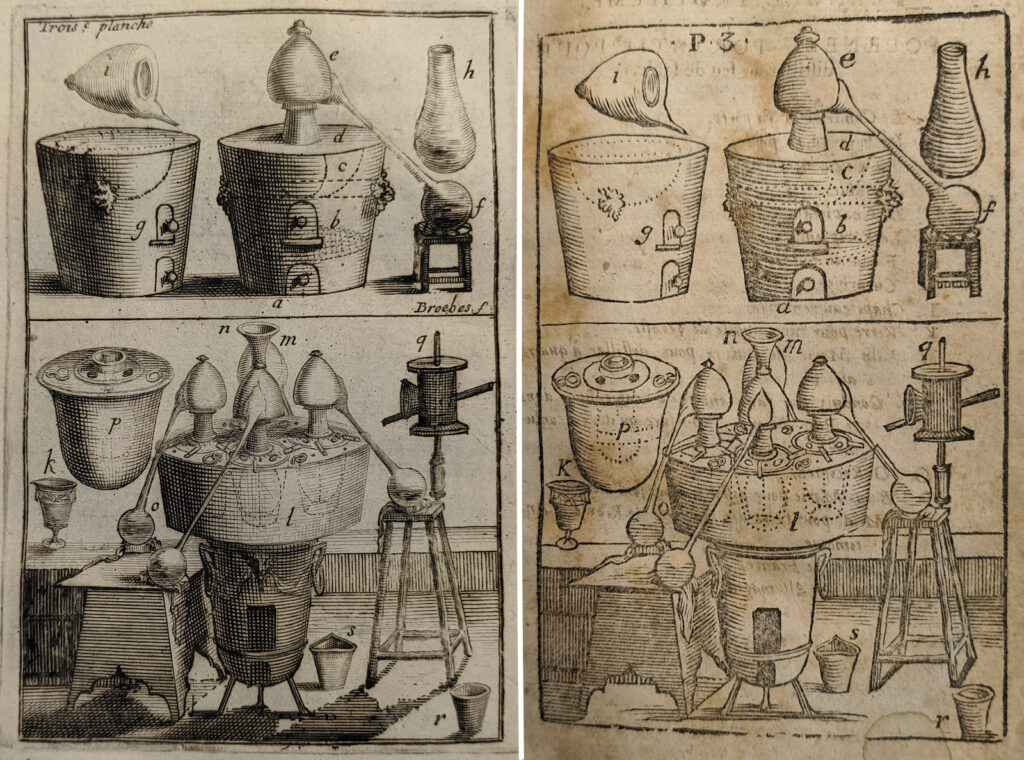
What about the Antoine de Harsy edition of Paracelsus that claimed to be published in Lyon but may well have originated in Geneva? At first I saw a smoking gun on the title page. The year of publication is given in Roman numerals but in italics. This seems to have been a rare practice confined to Frankfurt, Geneva, and . . . Lyon. No luck there. And come to think of it, if the accusations against de Harsy and his coreligionists are accurate—that when they relocated to Geneva they took Lyonnais journeymen with them—then we would expect to see characteristically Lyonnais printing practices in books published in Geneva. This book will clearly need closer examination, and there are additional avenues to pursue. It turns out that Lyon had its own type foundry, and we may be able to find type or ornament features that are distinctly Lyonnais.
So where does this leave the thesis I set out with, the Cours de chymie being the epitome of the chemical textbook of the 17th century in its many editions and reprintings? After I reported on the widespread piracy of Lemery’s work at a meeting of the American Chemical Society, Lawrence Principe, a chemist and historian of science at Johns Hopkins University, said that it brought some peculiarities of the Cours de chymie into focus. He had noticed that Lemery’s revisions to the text were sometimes slapdash, that Lemery would add new material without bothering to remove previous text that directly contradicted it. We both now suspect that the book’s reputation is an illusion. Rather than being the crowning work in the tradition of 17th-century chemical textbooks, improving with each edition as Lemery added new material, it more probably represents a chaotic battleground, each edition a skirmish in which Lemery tries desperately to update the work in order to get out ahead of the pirates who inexorably dogged him.

